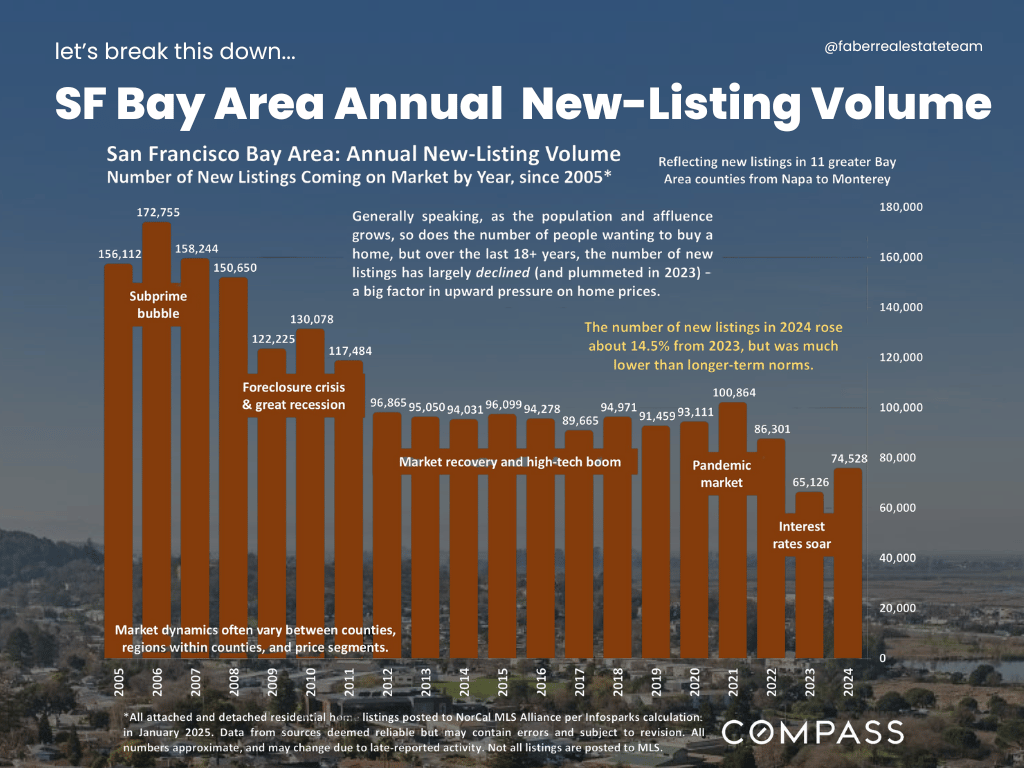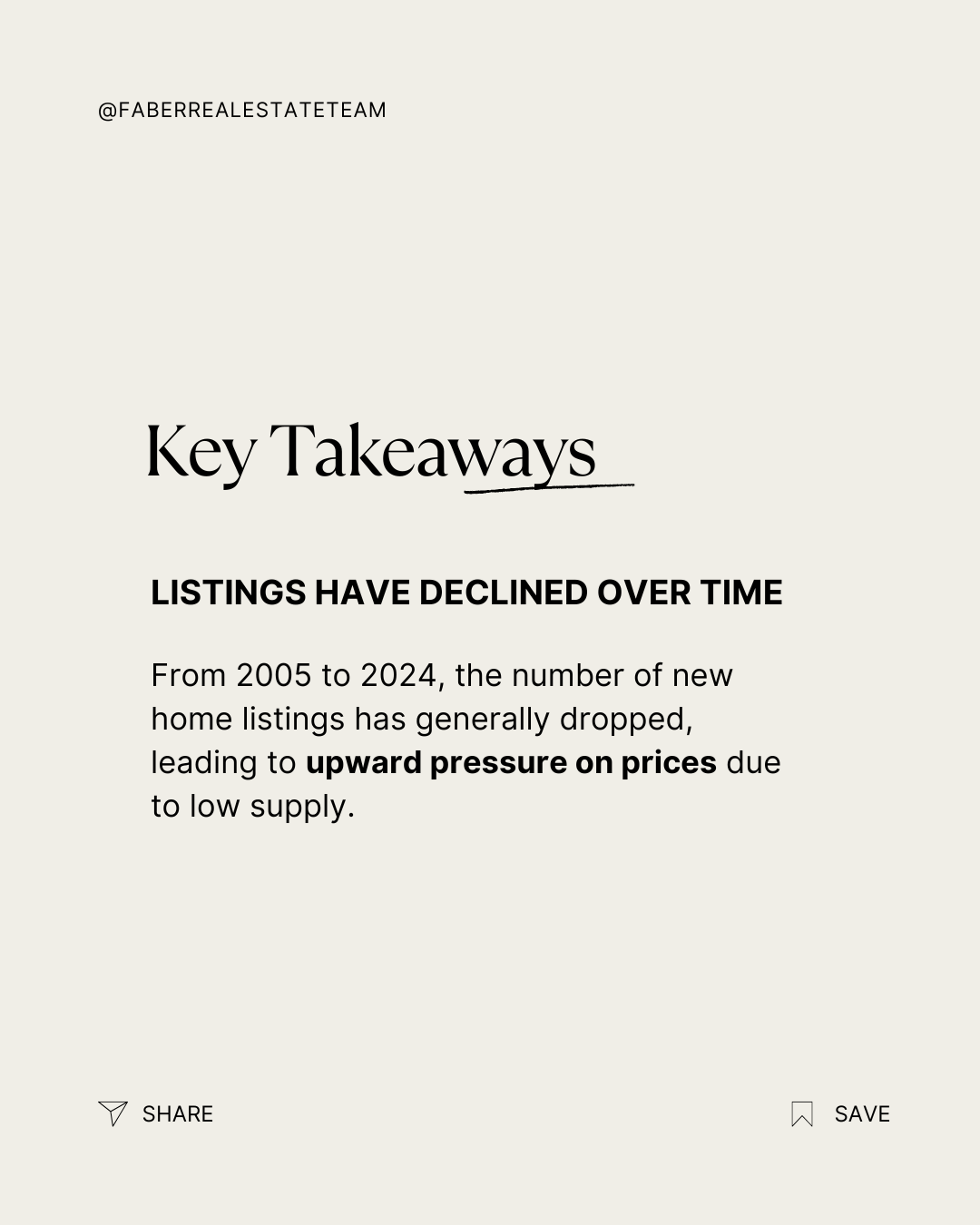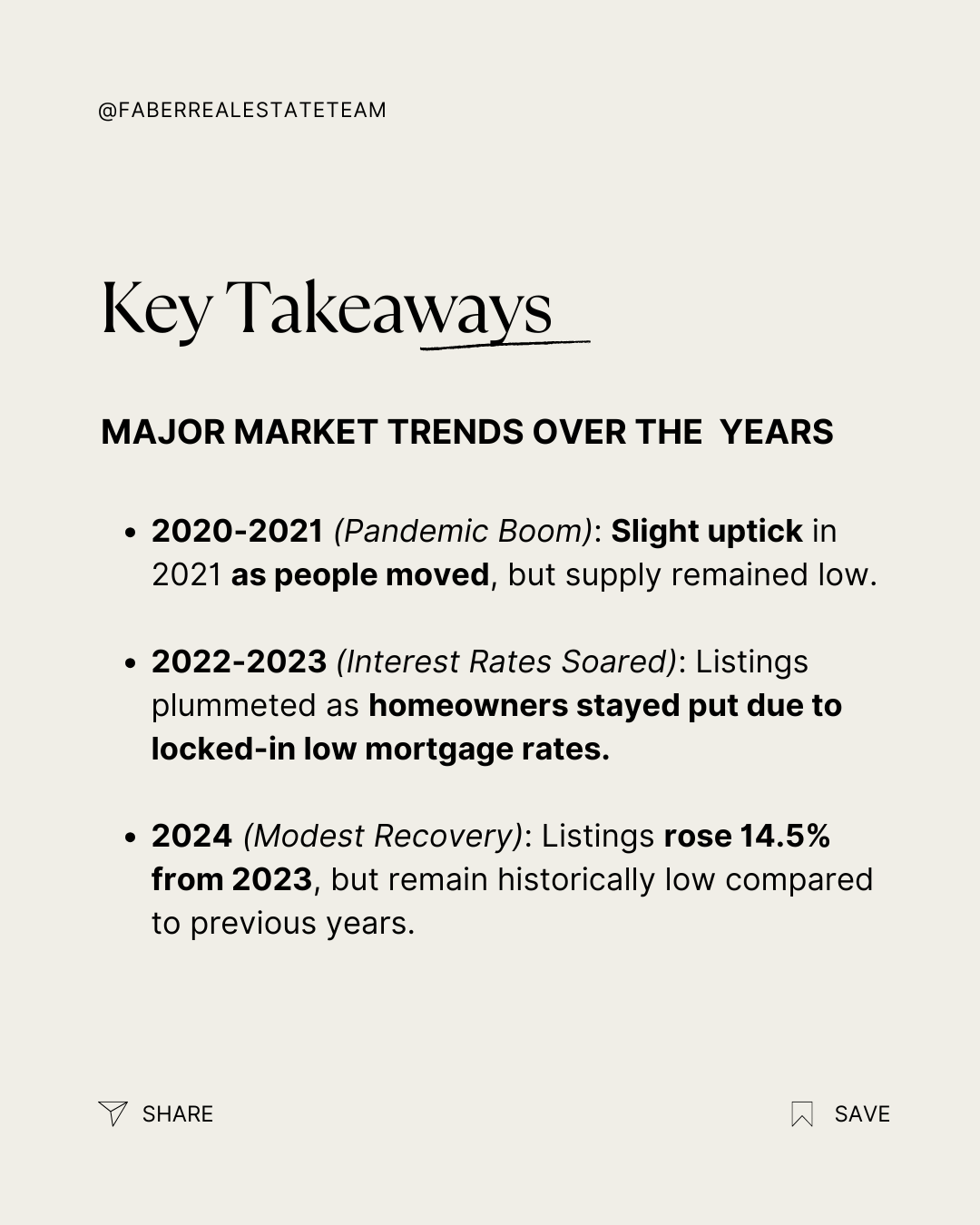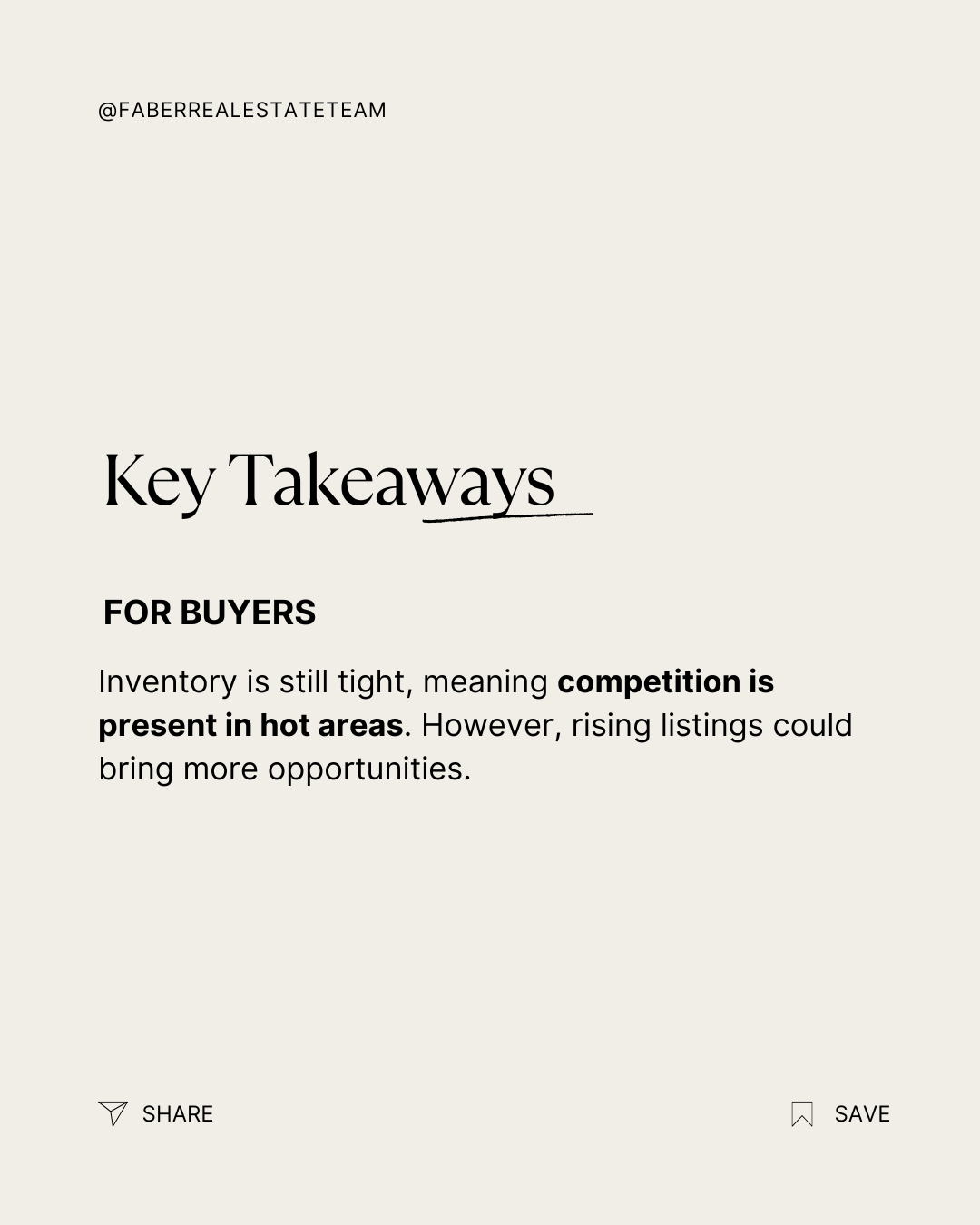Bay Area Real Estate: Understanding New-Listing Trends & What It Means for You
The Bay Area real estate market has evolved significantly over the past two decades. One of the most telling indicators of market movement is the number of new home listings, which helps shape housing availability, pricing trends, and overall buyer and seller behavior.
As we reflect on data from 2005 to 2024, it’s clear that the market has gone through several economic cycles, each influencing how many homes come to market and the competitive landscape for buyers and sellers.
Let’s break down these trends and explore how they impact today’s real estate decisions.
Listings Have Declined Over Time
From 2005 to 2024, the number of new home listings has gradually decreased, shaping the supply and demand dynamics we see today.
Historically, as the population grows and housing demand increases, we would expect the number of new listings to rise accordingly. However, factors such as economic shifts, market cycles, and evolving homeowner preferences have resulted in a decline in new listings over the past 18+ years.
This lower inventory has played a significant role in maintaining home values, reinforcing real estate as a valuable long-term investment.
Major Market Trends Over the Years
The past two decades have seen distinct market cycles, each contributing to changes in new home listings:
- 2005-2007: Subprime Boom – High Listing Volume
During the housing boom, many homeowners listed their properties, taking advantage of favorable market conditions. The availability of easy financing and rapid home appreciation encouraged frequent buying and selling.
- 2008-2010: Foreclosure Crisis & Great Recession
Following the housing crisis, listings dropped significantly as homeowners held onto their properties, navigating economic uncertainty. Many homes were removed from the market due to financial restructuring and market adjustments.
- 2011-2019: Recovery & Tech Boom
The market stabilized during this period, with steady new listings, although they never returned to the high levels of the early 2000s. Economic growth, especially in the Bay Area tech sector, fueled strong demand, leading to a highly competitive housing market.
- 2020-2021: Pandemic Boom
The pandemic reshaped how people viewed housing. A slight uptick in 2021 listings reflected shifts in homeowner preferences, as remote work, lifestyle changes, and relocation trends influenced the market. However, supply remained lower than demand, keeping the market highly competitive.
- 2022-2023: Interest Rate Adjustments
The market saw a reduction in new listings as many homeowners with historically low mortgage rates opted to hold onto their properties rather than move. This led to limited supply, reinforcing strong price stability across the Bay Area.
- 2024: Modest Recovery
The number of new listings increased by 14.5% from 2023, reflecting more movement in the market. While this is a positive sign for buyers, inventory remains historically low compared to long-term norms.
What This Means for Buyers & Sellers in 2025
The Bay Area real estate market continues to evolve, and understanding how 2024’s trends shape 2025 opportunities is key to making informed decisions. Whether you’re a buyer looking for the right opportunity or a seller aiming to maximize value, market conditions offer new possibilities for both sides.
What Buyers Need to Know in 2025
With new home listings rising 14.5% in 2024, the market is offering more choices for buyers than in previous years. However, demand remains strong in desirable neighborhoods, meaning strategy is key when navigating the market.
-
More Inventory, More Choices
While inventory levels are still below historical norms, the increase in listings provides greater selection across different price points. Buyers now have more opportunities to explore homes that align with their needs and lifestyle.
✔ More listings reduce the urgency to overbid, allowing buyers to find homes that match their priorities.
✔ More variety in home types (single-family homes, condos, and investment properties) gives buyers greater flexibility.
✔ Inventory shifts can lead to better negotiation power in some markets, particularly for homes that have been on the market longer
-
Competition Still Exists, but Opportunities Are Emerging
While the number of homes available has increased, certain price points and locations remain highly competitive. Understanding where opportunities exist will help buyers move quickly and strategically.
✔ Highly desirable locations, such as Marin, San Francisco, and Silicon Valley, still see strong buyer demand.
✔ New construction homes and up-and-coming neighborhoods may present better buying opportunities.
✔ Buyers who are pre-approved and ready to act will have an advantage when competing for the best homes.
-
A Smart, Strategic Approach is Essential
With evolving mortgage rates, shifting inventory levels, and varying competition by location, working with an experienced real estate team can help buyers make confident, informed decisions.
✔ Understanding local market trends is critical—what’s happening in San Mateo County may be different from trends in Alameda.
✔ Timing matters—certain months of the year may offer more favorable conditions for buyers.
✔ Negotiation strategies can make a difference in securing the best deal, especially as inventory levels adjust.
Key Takeaway for Buyers:
➡ 2025 offers more options, but competition is still present. Strategic planning, expert guidance, and market awareness will be key to finding the right home at the right price.
Thinking about buying a home this year? Let’s discuss your goals and create a customized plan to find the perfect home. Reach out to us or schedule a buyer consultation today!
Interested in working with us as a Buyer? Click here to learn more!
What Sellers Need to Know in 2025
While more homes are coming to market, inventory remains historically low compared to long-term trends. This creates a unique advantage for sellers who position their properties correctly and competitively.
-
Less Inventory Means Your Home Stands Out
Even though 2024 saw an increase in listings, the overall supply of homes remains below long-term norms. This continues to favor sellers, particularly those who present their homes effectively.
✔ Well-prepared homes can attract strong offers quickly in a market where buyers are still competing.
✔ Sellers who list early in 2025 may benefit from lower competition before new spring inventory increases.
✔ The right listing price and marketing strategy can make a significant impact on selling success.
-
Strong Demand is Keeping Prices Steady
Despite rising inventory, home values remained strong in 2024, and this trend is expected to continue in 2025, particularly in well-located and well-maintained properties.
✔ Buyers are still motivated and ready to move when the right home becomes available.
✔ Pricing competitively attracts multiple buyers, increasing the potential for strong offers.
✔ Homes in top school districts, desirable neighborhoods, and with recent upgrades will continue to see significant buyer interest
-
Strategic Marketing & Pricing are More Important Than Ever
As more listings enter the market, sellers must ensure their home stands out. Working with a real estate team that knows how to position a home effectively is essential for maximizing value and securing the right buyer.
✔ Staging, professional photography, and targeted marketing will make a home more appealing.
✔ A customized pricing strategy based on current market trends ensures the home attracts the right buyers.
✔ Negotiation expertise can help sellers navigate multiple-offer situations or adjust strategies if needed.
Key Takeaway for Sellers:
➡ Even with more listings, market conditions still favor well-prepared sellers. Proper pricing, presentation, and expert marketing strategies will be key to maximizing value in 2025.
Thinking about selling in 2025? Let’s craft a marketing plan to get your home sold quickly and for the best price. Reach out to us to talk about your listing goals!
Interested in working with us as a Seller? Click here to learn more!
Key Takeaway: 2025 Brings New Opportunities
Every market cycle presents unique opportunities for buyers, sellers, and investors. With new listings increasing but still below historical norms, understanding market trends and making data-driven decisions is essential for success.
Whether you’re considering buying, selling, or investing, having an expert strategy can help you navigate the market with confidence.
Interested in a personalized market update? Let’s connect! Reach out to discuss how you can take advantage of 2025’s real estate trends.
Faber Real Estate Team | Compass
[email protected]
415.686.4980





